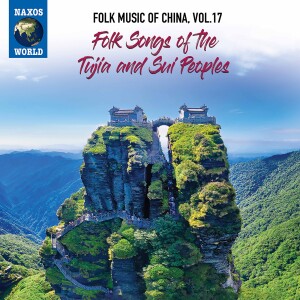 This disc, the 17th of 20 releases from Naxos highlighting the varied folk music of China, focuses on two ethnic groups, the Tujia and Sui peoples. They live mostly in several landlocked provinces of south-central china, the Sui in Guizhou, the Tujia in Hunan, Hubei, Guizhou and Chongqing. The folk songs of each of these groups is as distinctive as any of the music presented on other releases in this excellent series. This album has 17 songs, eight from the Tujia and nine from the Sui.
This disc, the 17th of 20 releases from Naxos highlighting the varied folk music of China, focuses on two ethnic groups, the Tujia and Sui peoples. They live mostly in several landlocked provinces of south-central china, the Sui in Guizhou, the Tujia in Hunan, Hubei, Guizhou and Chongqing. The folk songs of each of these groups is as distinctive as any of the music presented on other releases in this excellent series. This album has 17 songs, eight from the Tujia and nine from the Sui.
The Tujia are mountain folk, living in the vast Wuling Mountains in those four provinces, and even without knowing that, many of these songs, which were all recorded in Hubei, reflect that fact. The first several tracks are fairly short chant songs, which are sung at weddings and other ceremonial occasions. They generally feature back-and-forth verses sung alternately by two singers, who often then join in unison for a final stanza or two. On the song “Raise Our Glasses to Our Hometown” two women sing in very high voices in unison, then are answered by another group of two or more, sounding for all the world like people calling to one another across a deep valley from a couple of mountaintops.
There are also a couple of lovely narrative songs, “The Fisherman Song,” and “South Song of Changyang” featuring a small three-stringed lute and bones or sticks for percussion, which are typical of this kind of song. There are several other charming songs by solo or small ensemble female voices with great titles like “Silly Son-in-Law” and “Comb With Hair Oil.” Real standouts are “Woodpecker,” a male solo performance with vocals that at times soar loftily and then melodically describe the titular bird’s movements; and the funeral dance “Sa Ye’er Ho,” an impressive and passionate ensemble performance in which the lead singer also plays a drum and the backing singers repeat the stanzas while dancing. In this type of ritual dance song, the Tujia traditionally cry for daughters at weddings and dance happily for the deceased at funerals, in accordance with their spiritual traditions.
The Sui songs are longer and more elaborate, mostly by solo male singers with the exception of one love song that features a long set of verses by a man, followed by a shorter section by a woman. Four of them, including “Festival Song” and “When Spring Comes,” are known as “ancient songs,” which are variously ballads, funeral odes and “reasoning” songs. The Tujia songs are all impressive performances, but as a whole are a bit less interesting to an outsider because of the lack of variety.
Overall though, Folk Songs of the Tujia and Sui Peoples is a worthy installment in this great series.
Listen to samples and learn more on the Naxos website.
(Naxos, 2021)
